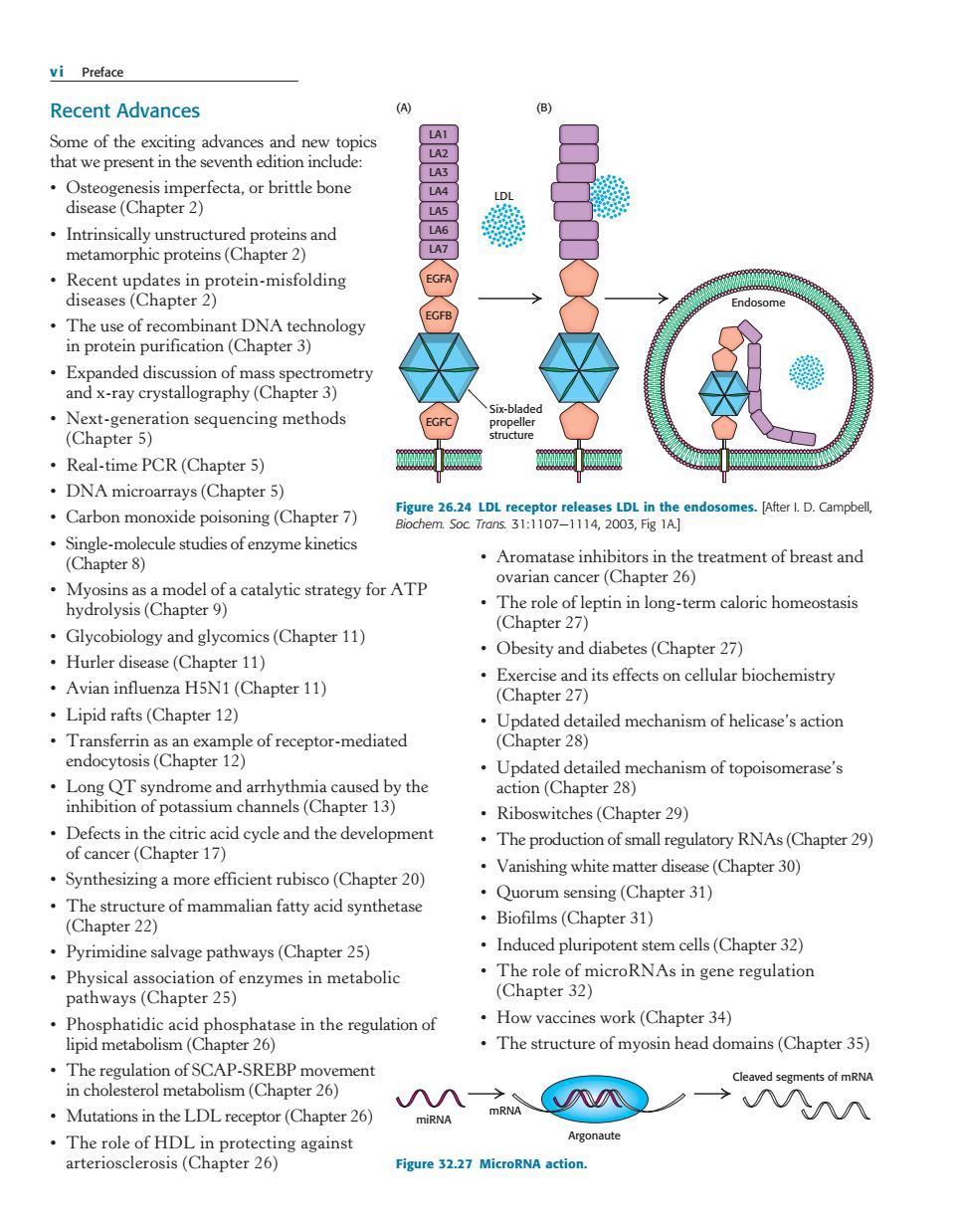正在加载图片...

vi Preface Recent Advances ( () Some of the exciting advances and new topics LAI LA2 that we present in the seventh edition include: LA3 Osteogenesis imperfecta,or brittle bone LA4 LDL disease(Chapter 2) LAS Intrinsically unstructured proteins and LA6 metamorphic proteins(Chapter 2) LA7 Recent updates in protein-misfolding EGFA diseases(Chapter 2) Endosome The use of recombinant DNA technology EGFB in protein purification(Chapter 3) Expanded discussion of mass spectrometry and x-ray crystallography(Chapter 3) Six-bladed Next-generation sequencing methods propeller (Chapter 5) structure Real-time PCR(Chapter 5) DNA microarrays(Chapter 5) Figure 26.24 LDL receptor releases LDL in the endosomes.[After I.D.Campbell, Carbon monoxide poisoning(Chapter 7) Biochem.Soc.Trans.31:1107-1114,2003,Fig 1A.] Single-molecule studies of enzyme kinetics (Chapter 8) Aromatase inhibitors in the treatment of breast and ovarian cancer(Chapter 26) Myosins as a model of a catalytic strategy for ATP hydrolysis(Chapter 9) The role of leptin in long-term caloric homeostasis (Chapter 27) Glycobiology and glycomics(Chapter 11) Obesity and diabetes(Chapter 27) Hurler disease(Chapter 11) Avian influenza H5N1(Chapter 11) Exercise and its effects on cellular biochemistry (Chapter 27) Lipid rafts(Chapter 12) Updated detailed mechanism of helicase's action Transferrin as an example of receptor-mediated (Chapter 28) endocytosis(Chapter 12) Updated detailed mechanism of topoisomerase's Long QT syndrome and arrhythmia caused by the action(Chapter 28) inhibition of potassium channels(Chapter 13) Riboswitches(Chapter 29) Defects in the citric acid cycle and the development The production of small regulatory RNAs(Chapter 29) of cancer(Chapter 17) Vanishing white matter disease(Chapter 30) Synthesizing a more efficient rubisco(Chapter 20) Quorum sensing(Chapter 31) The structure of mammalian fatty acid synthetase (Chapter 22) Biofilms(Chapter 31) Pyrimidine salvage pathways(Chapter 25) Induced pluripotent stem cells(Chapter 32) Physical association of enzymes in metabolic The role of microRNAs in gene regulation pathways(Chapter 25) (Chapter 32) Phosphatidic acid phosphatase in the regulation of How vaccines work (Chapter 34) lipid metabolism(Chapter 26) The structure of myosin head domains(Chapter 35) The regulation of SCAP-SREBP movement Cleaved segments of mRNA in cholesterol metabolism(Chapter 26) Mutations in the LDL receptor(Chapter 26) mRNA miRNA The role of HDL in protecting against Argonaute arteriosclerosis(Chapter 26) Figure 32.27 MicroRNA action.Recent Advances Some of the exciting advances and new topics that we present in the seventh edition include: • Osteogenesis imperfecta, or brittle bone disease (Chapter 2) • Intrinsically unstructured proteins and metamorphic proteins (Chapter 2) • Recent updates in protein-misfolding diseases (Chapter 2) • The use of recombinant DNA technology in protein purification (Chapter 3) • Expanded discussion of mass spectrometry and x-ray crystallography (Chapter 3) • Next-generation sequencing methods (Chapter 5) • Real-time PCR (Chapter 5) • DNA microarrays (Chapter 5) • Carbon monoxide poisoning (Chapter 7) • Single-molecule studies of enzyme kinetics (Chapter 8) • Myosins as a model of a catalytic strategy for ATP hydrolysis (Chapter 9) • Glycobiology and glycomics (Chapter 11) • Hurler disease (Chapter 11) • Avian influenza H5N1 (Chapter 11) • Lipid rafts (Chapter 12) • Transferrin as an example of receptor-mediated endocytosis (Chapter 12) • Long QT syndrome and arrhythmia caused by the inhibition of potassium channels (Chapter 13) • Defects in the citric acid cycle and the development of cancer (Chapter 17) • Synthesizing a more efficient rubisco (Chapter 20) • The structure of mammalian fatty acid synthetase (Chapter 22) • Pyrimidine salvage pathways (Chapter 25) • Physical association of enzymes in metabolic pathways (Chapter 25) • Phosphatidic acid phosphatase in the regulation of lipid metabolism (Chapter 26) • The regulation of SCAP-SREBP movement in cholesterol metabolism (Chapter 26) • Mutations in the LDL receptor (Chapter 26) • The role of HDL in protecting against arteriosclerosis (Chapter 26) • Aromatase inhibitors in the treatment of breast and ovarian cancer (Chapter 26) • The role of leptin in long-term caloric homeostasis (Chapter 27) • Obesity and diabetes (Chapter 27) • Exercise and its effects on cellular biochemistry (Chapter 27) • Updated detailed mechanism of helicase’s action (Chapter 28) • Updated detailed mechanism of topoisomerase’s action (Chapter 28) • Riboswitches (Chapter 29) • The production of small regulatory RNAs (Chapter 29) • Vanishing white matter disease (Chapter 30) • Quorum sensing (Chapter 31) • Biofilms (Chapter 31) • Induced pluripotent stem cells (Chapter 32) • The role of microRNAs in gene regulation (Chapter 32) • How vaccines work (Chapter 34) • The structure of myosin head domains (Chapter 35) vi Preface Figure 26.24 LDL receptor releases LDL in the endosomes. [After I. D. Campbell, Biochem. Soc. Trans. 31:1107 —1114, 2003, Fig 1A.] (A) (B) LA1 LA2 LDL LA3 LA4 LA5 LA6 LA7 EGFA EGFB Six-bladed propeller structure Endosome EGFC Cleaved segments of mRNA mRNA miRNA Argonaute Figure 32.27 MicroRNA action